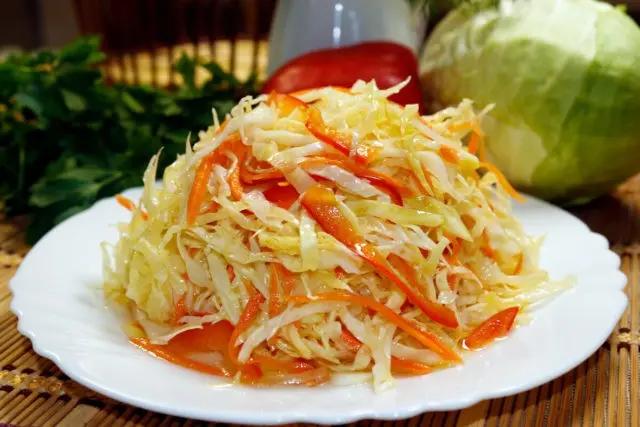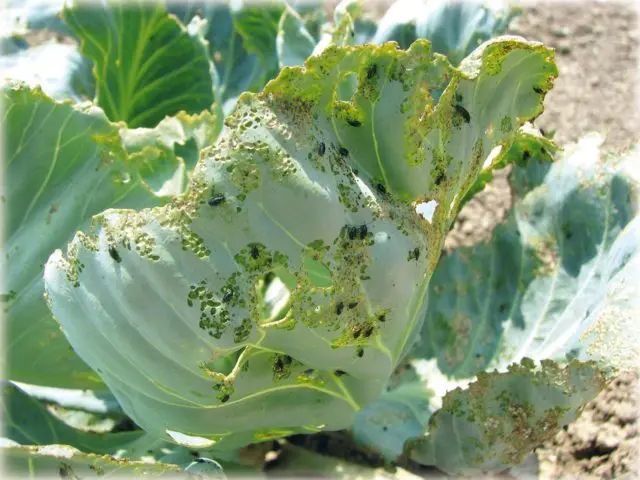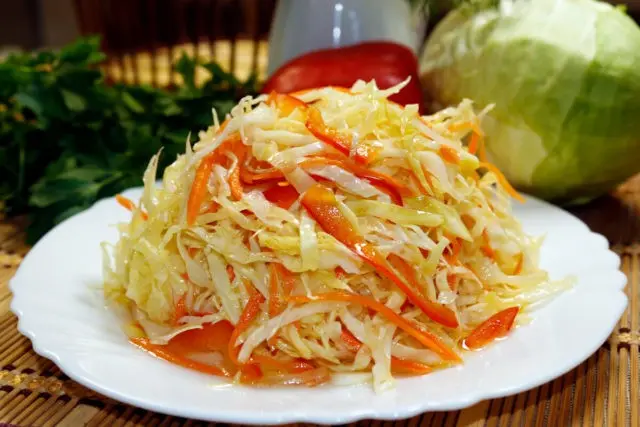Contents
Kolya cabbage is a late white-headed species. It is a hybrid of Dutch origin. It is popular with gardeners because it is very resistant to diseases and pests. Its heads are quite dense and do not crack during development. Suitable for pickling and preparing fresh salads.
Characteristics of cabbage Kohl

Hybrid Kohl is resistant to cracking
This white cabbage hybrid was grown by Dutch breeders. Many farmers and gardeners have appreciated all the qualities of the Kolya hybrid. Cabbage appeared in Our Country in 2010. Almost immediately it was found that it is resistant to unexpected weather changes, insect pests and many diseases. Greenhouse conditions are not required for this cabbage.
Description of cabbage Kolya F1: it has a rather high stalk (up to 10 cm). Ripe cabbage reaches 23 cm in diameter, and its weight can be from 3 to 8 kg. Sheet plates do not differ in special width. Their edges are slightly wavy, covered with a slight coating. The upper surface of the fruit is green with a bluish tint, inside it is white-yellow. Refers to late-ripening crops. Fruits with firm structure, leaves well adjoin to each other.
Advantages and disadvantages
Gardeners consider the main advantage of Kohl’s cabbage to be resistance to cracking, but this hybrid has a number of other advantages. The most important advantages include:
- the culture is very resistant to fungal infections;
- the most common cultivation conditions lead to good yields;
- taste properties allow you to use raw cabbage for salads;
- fast adaptation to weather conditions;
- the crop can be harvested using mechanisms;
- when evaluating the shelf life, it was found that cabbage can lie up to 10 months;
- during long-term transportation, cabbage does not lose its appearance.
Gardeners also noted some of the disadvantages of the Kolya hybrid. For example, difficulties in growing from seeds and frequent breakage of the stalk with insufficient soil hilling.
The yield of white cabbage Kohl
The yield of the Kolya hybrid is 7-9 kg of cabbage per square. When grown on an industrial scale, about 380-500 centners of forks are harvested per hectare.
Planting and caring for Kolya cabbage

Growing seedlings, you need to take care of sufficient lighting of seedlings.
Seeds for seedlings begin to be sown in March-April. It should be noted that shoots appear on the 8-10th day. Landing in the ground is carried out after 50 days. The soil must be prepared in advance – treat it with a solution of potassium permanganate. The planting material itself is also disinfected – soaked for 10-15 minutes in a saturated solution of potassium permanganate. After that, the seeds must be washed and dried.
When the sprouts form the first few leaves, the seedlings swoop down and fertilize. Two weeks before the proposed planting, seedlings should be hardened off. Containers with cabbage are taken out first for a couple of hours in fresh air, then the time is increased. The last 2-3 days, the sprouts do not need to be removed into the room at all.
In the southern regions, it is possible to grow Kolya cabbage, bypassing a separate planting of seedlings. Seeds are sown immediately in open ground, deepening them by 2 cm. With this method, the first shoots should appear on the 5-7th day.
On the 50th day before planting seedlings, each sprout should have 5-6 leaves. First, they should be watered abundantly. The beds are formed at a distance of 50 cm from each other. The holes need to be fertilized. Seedlings are removed and deepened into the ground to the first leaf. Next, the holes should be poured with water, as they are absorbed, they are covered with soil. It must be mulched, preventing the evaporation of the liquid.
Basic care
Watering should be done every 4-6 days if there is no drought. The first loosening is carried out 10 days after planting in the ground, and then it is desirable to carry it out after each watering or rain. This will avoid the formation of a dense crust and provide oxygen access to the root system. Hilling cabbage Kohl produced 18-21 days after planting, and then after 2 weeks. This is necessary so that the cabbage does not fall on its side, since the variety has a long stalk. During the period of growth and development, fertilizers should be applied about 4 times.
Diseases and pests

Culture after the attack of leaf-eating insects is very difficult to recover
Kolya cabbage perfectly resists diseases and attacks of insect pests, but with proper care. The variety may be subject to the following diseases:
- blackleg;
- white rot;
- hernia.
Experienced gardeners do not recommend pre-treatment of the culture from these diseases. The immunity of cabbage should cope with them on its own. If the plant has been damaged, then the leaves and heads of cabbage must be destroyed, and the rest, which did not have time to get sick, must be treated with special means.
Of the pests, you need to be wary of the cabbage fly, which is especially active in early summer, and leaf-eating insects. You should be aware that spraying can be done only before the start of tying the forks.
Leaf-eating insects include: cabbage aphids, whites, moths, scoops, bugs. You can fight these pests with a solution of technical chlorophos and phosphomide.
Application

The culture is not bitter and is suitable for making fresh salads.
Kolya cabbage tolerates heat treatment well, without losing its taste. Since the culture is not bitter, it can be used raw for salads. But it is good both stewed and fried. Ideal for preservation, fermentation, salting. Since Kohl’s cabbage is resistant to cracking, it can be stored for a very long time.
Conclusion
Kolya cabbage is a hybrid crop. Gained popularity in Our Country due to resistance to pests and diseases. In addition, the main distinguishing feature of the variety is the absence of cracks during the development and growth of the culture. Unpretentious in care and has a pleasant taste.









